roof rack DODGE RAM 2002 Service Repair Manual
[x] Cancel search | Manufacturer: DODGE, Model Year: 2002, Model line: RAM, Model: DODGE RAM 2002Pages: 2255, PDF Size: 62.07 MB
Page 519 of 2255
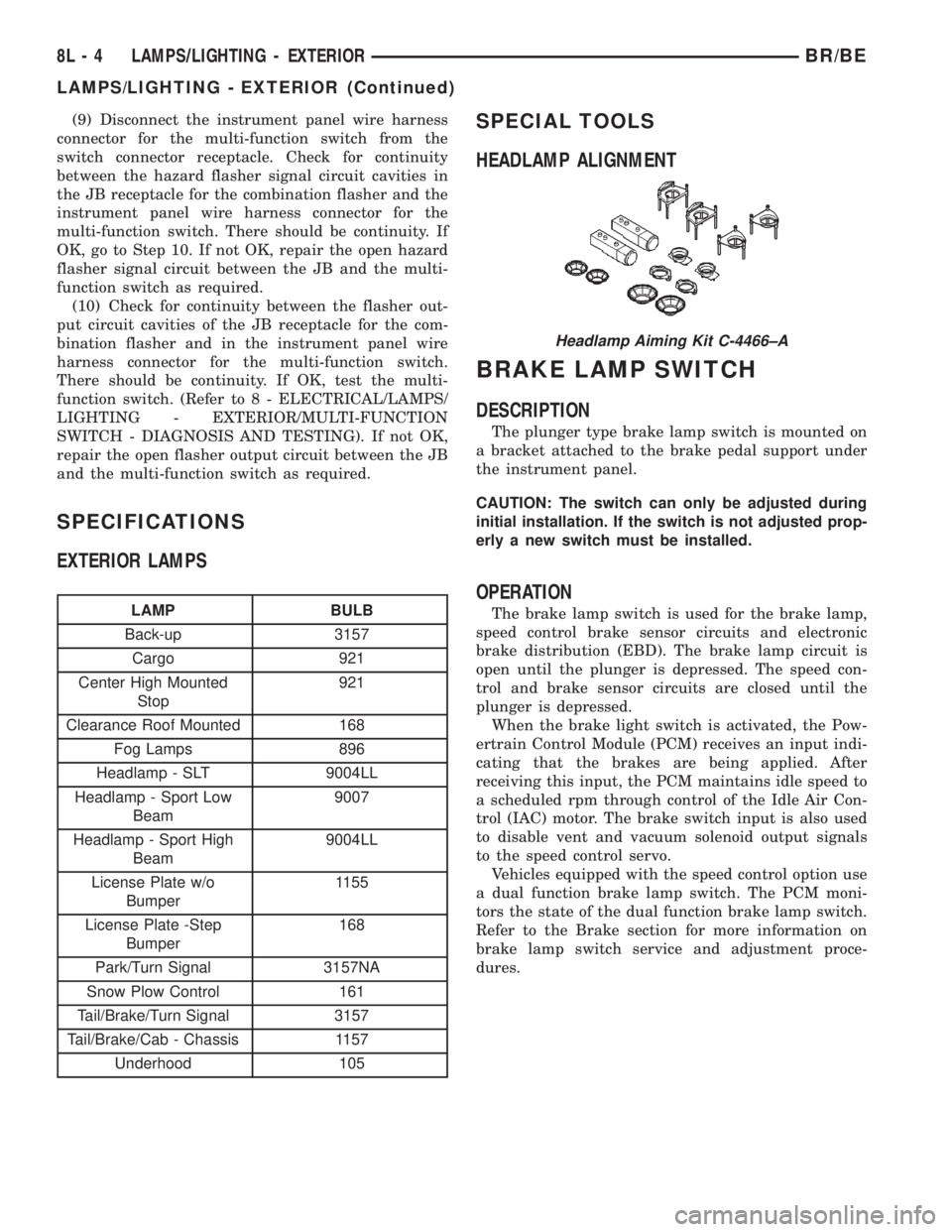
(9) Disconnect the instrument panel wire harness
connector for the multi-function switch from the
switch connector receptacle. Check for continuity
between the hazard flasher signal circuit cavities in
the JB receptacle for the combination flasher and the
instrument panel wire harness connector for the
multi-function switch. There should be continuity. If
OK, go to Step 10. If not OK, repair the open hazard
flasher signal circuit between the JB and the multi-
function switch as required.
(10) Check for continuity between the flasher out-
put circuit cavities of the JB receptacle for the com-
bination flasher and in the instrument panel wire
harness connector for the multi-function switch.
There should be continuity. If OK, test the multi-
function switch. (Refer to 8 - ELECTRICAL/LAMPS/
LIGHTING - EXTERIOR/MULTI-FUNCTION
SWITCH - DIAGNOSIS AND TESTING). If not OK,
repair the open flasher output circuit between the JB
and the multi-function switch as required.
SPECIFICATIONS
EXTERIOR LAMPS
LAMP BULB
Back-up 3157
Cargo 921
Center High Mounted
Stop921
Clearance Roof Mounted 168
Fog Lamps 896
Headlamp - SLT 9004LL
Headlamp - Sport Low
Beam9007
Headlamp - Sport High
Beam9004LL
License Plate w/o
Bumper1155
License Plate -Step
Bumper168
Park/Turn Signal 3157NA
Snow Plow Control 161
Tail/Brake/Turn Signal 3157
Tail/Brake/Cab - Chassis 1157
Underhood 105
SPECIAL TOOLS
HEADLAMP ALIGNMENT
BRAKE LAMP SWITCH
DESCRIPTION
The plunger type brake lamp switch is mounted on
a bracket attached to the brake pedal support under
the instrument panel.
CAUTION: The switch can only be adjusted during
initial installation. If the switch is not adjusted prop-
erly a new switch must be installed.
OPERATION
The brake lamp switch is used for the brake lamp,
speed control brake sensor circuits and electronic
brake distribution (EBD). The brake lamp circuit is
open until the plunger is depressed. The speed con-
trol and brake sensor circuits are closed until the
plunger is depressed.
When the brake light switch is activated, the Pow-
ertrain Control Module (PCM) receives an input indi-
cating that the brakes are being applied. After
receiving this input, the PCM maintains idle speed to
a scheduled rpm through control of the Idle Air Con-
trol (IAC) motor. The brake switch input is also used
to disable vent and vacuum solenoid output signals
to the speed control servo.
Vehicles equipped with the speed control option use
a dual function brake lamp switch. The PCM moni-
tors the state of the dual function brake lamp switch.
Refer to the Brake section for more information on
brake lamp switch service and adjustment proce-
dures.
Headlamp Aiming Kit C-4466±A
8L - 4 LAMPS/LIGHTING - EXTERIORBR/BE
LAMPS/LIGHTING - EXTERIOR (Continued)
Page 521 of 2255
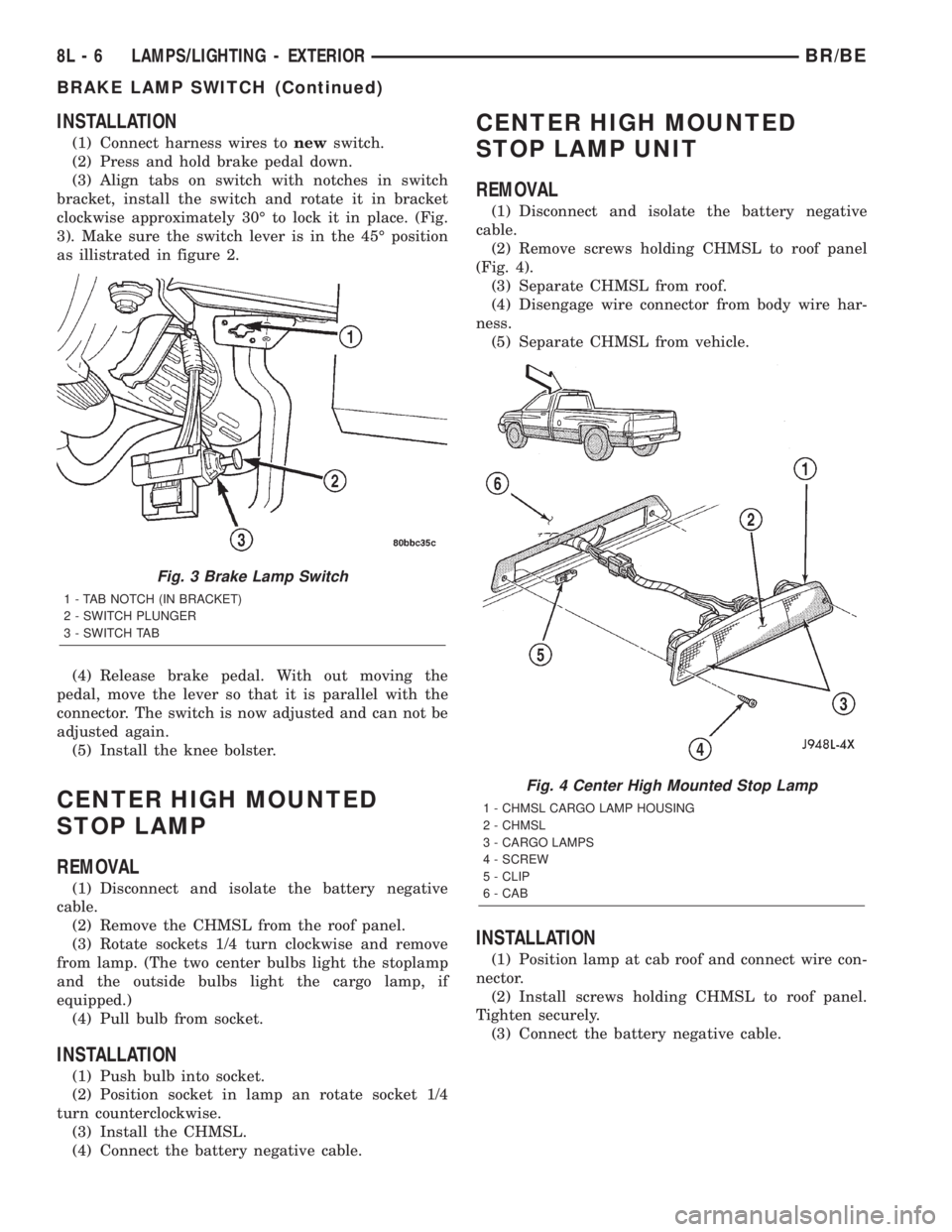
INSTALLATION
(1) Connect harness wires tonewswitch.
(2) Press and hold brake pedal down.
(3) Align tabs on switch with notches in switch
bracket, install the switch and rotate it in bracket
clockwise approximately 30É to lock it in place. (Fig.
3). Make sure the switch lever is in the 45É position
as illistrated in figure 2.
(4) Release brake pedal. With out moving the
pedal, move the lever so that it is parallel with the
connector. The switch is now adjusted and can not be
adjusted again.
(5) Install the knee bolster.
CENTER HIGH MOUNTED
STOP LAMP
REMOVAL
(1) Disconnect and isolate the battery negative
cable.
(2) Remove the CHMSL from the roof panel.
(3) Rotate sockets 1/4 turn clockwise and remove
from lamp. (The two center bulbs light the stoplamp
and the outside bulbs light the cargo lamp, if
equipped.)
(4) Pull bulb from socket.
INSTALLATION
(1) Push bulb into socket.
(2) Position socket in lamp an rotate socket 1/4
turn counterclockwise.
(3) Install the CHMSL.
(4) Connect the battery negative cable.
CENTER HIGH MOUNTED
STOP LAMP UNIT
REMOVAL
(1) Disconnect and isolate the battery negative
cable.
(2) Remove screws holding CHMSL to roof panel
(Fig. 4).
(3) Separate CHMSL from roof.
(4) Disengage wire connector from body wire har-
ness.
(5) Separate CHMSL from vehicle.
INSTALLATION
(1) Position lamp at cab roof and connect wire con-
nector.
(2) Install screws holding CHMSL to roof panel.
Tighten securely.
(3) Connect the battery negative cable.
Fig. 3 Brake Lamp Switch
1 - TAB NOTCH (IN BRACKET)
2 - SWITCH PLUNGER
3 - SWITCH TAB
Fig. 4 Center High Mounted Stop Lamp
1 - CHMSL CARGO LAMP HOUSING
2 - CHMSL
3 - CARGO LAMPS
4 - SCREW
5 - CLIP
6 - CAB
8L - 6 LAMPS/LIGHTING - EXTERIORBR/BE
BRAKE LAMP SWITCH (Continued)
Page 542 of 2255
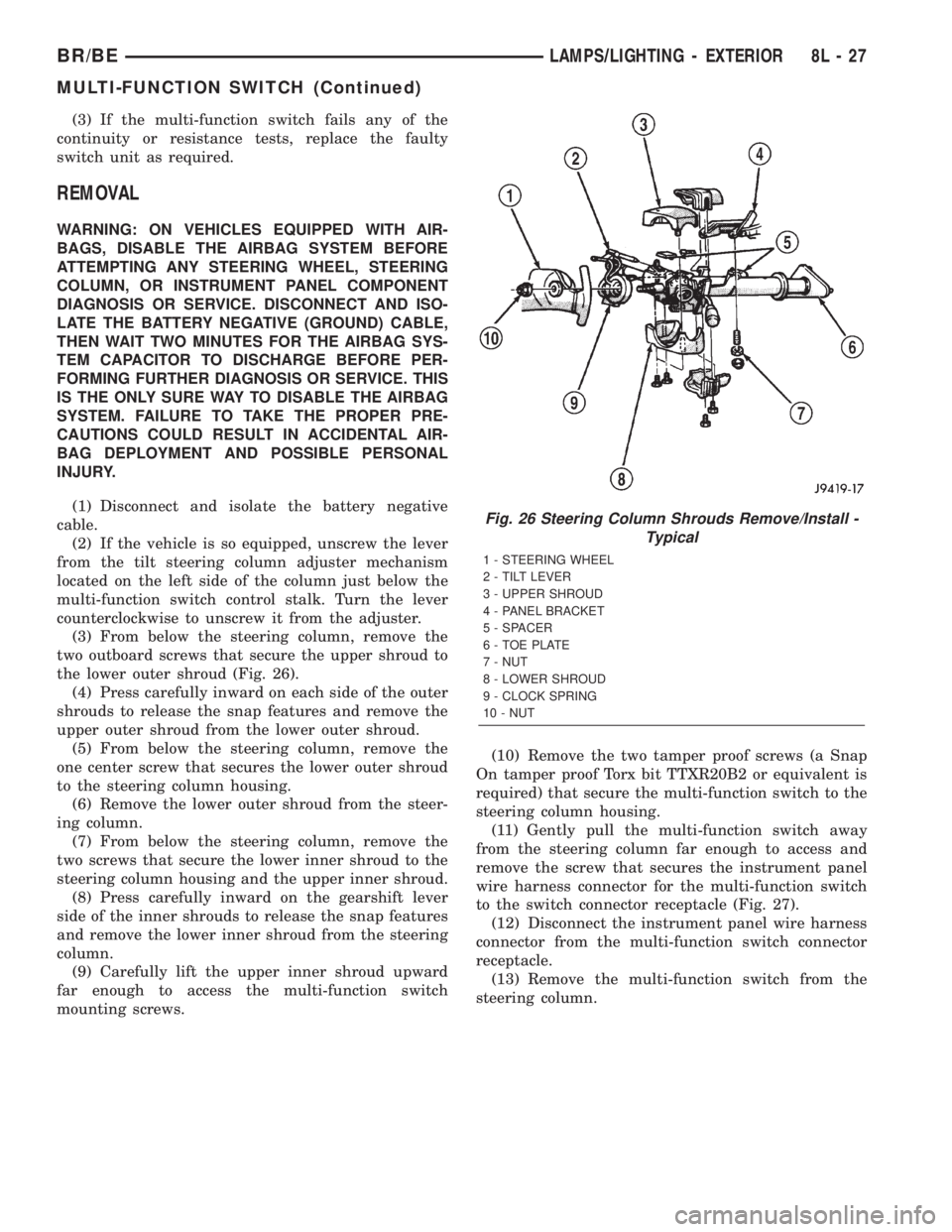
(3) If the multi-function switch fails any of the
continuity or resistance tests, replace the faulty
switch unit as required.
REMOVAL
WARNING: ON VEHICLES EQUIPPED WITH AIR-
BAGS, DISABLE THE AIRBAG SYSTEM BEFORE
ATTEMPTING ANY STEERING WHEEL, STEERING
COLUMN, OR INSTRUMENT PANEL COMPONENT
DIAGNOSIS OR SERVICE. DISCONNECT AND ISO-
LATE THE BATTERY NEGATIVE (GROUND) CABLE,
THEN WAIT TWO MINUTES FOR THE AIRBAG SYS-
TEM CAPACITOR TO DISCHARGE BEFORE PER-
FORMING FURTHER DIAGNOSIS OR SERVICE. THIS
IS THE ONLY SURE WAY TO DISABLE THE AIRBAG
SYSTEM. FAILURE TO TAKE THE PROPER PRE-
CAUTIONS COULD RESULT IN ACCIDENTAL AIR-
BAG DEPLOYMENT AND POSSIBLE PERSONAL
INJURY.
(1) Disconnect and isolate the battery negative
cable.
(2) If the vehicle is so equipped, unscrew the lever
from the tilt steering column adjuster mechanism
located on the left side of the column just below the
multi-function switch control stalk. Turn the lever
counterclockwise to unscrew it from the adjuster.
(3) From below the steering column, remove the
two outboard screws that secure the upper shroud to
the lower outer shroud (Fig. 26).
(4) Press carefully inward on each side of the outer
shrouds to release the snap features and remove the
upper outer shroud from the lower outer shroud.
(5) From below the steering column, remove the
one center screw that secures the lower outer shroud
to the steering column housing.
(6) Remove the lower outer shroud from the steer-
ing column.
(7) From below the steering column, remove the
two screws that secure the lower inner shroud to the
steering column housing and the upper inner shroud.
(8) Press carefully inward on the gearshift lever
side of the inner shrouds to release the snap features
and remove the lower inner shroud from the steering
column.
(9) Carefully lift the upper inner shroud upward
far enough to access the multi-function switch
mounting screws.(10) Remove the two tamper proof screws (a Snap
On tamper proof Torx bit TTXR20B2 or equivalent is
required) that secure the multi-function switch to the
steering column housing.
(11) Gently pull the multi-function switch away
from the steering column far enough to access and
remove the screw that secures the instrument panel
wire harness connector for the multi-function switch
to the switch connector receptacle (Fig. 27).
(12) Disconnect the instrument panel wire harness
connector from the multi-function switch connector
receptacle.
(13) Remove the multi-function switch from the
steering column.
Fig. 26 Steering Column Shrouds Remove/Install -
Typical
1 - STEERING WHEEL
2 - TILT LEVER
3 - UPPER SHROUD
4 - PANEL BRACKET
5 - SPACER
6 - TOE PLATE
7 - NUT
8 - LOWER SHROUD
9 - CLOCK SPRING
10 - NUT
BR/BELAMPS/LIGHTING - EXTERIOR 8L - 27
MULTI-FUNCTION SWITCH (Continued)
Page 565 of 2255
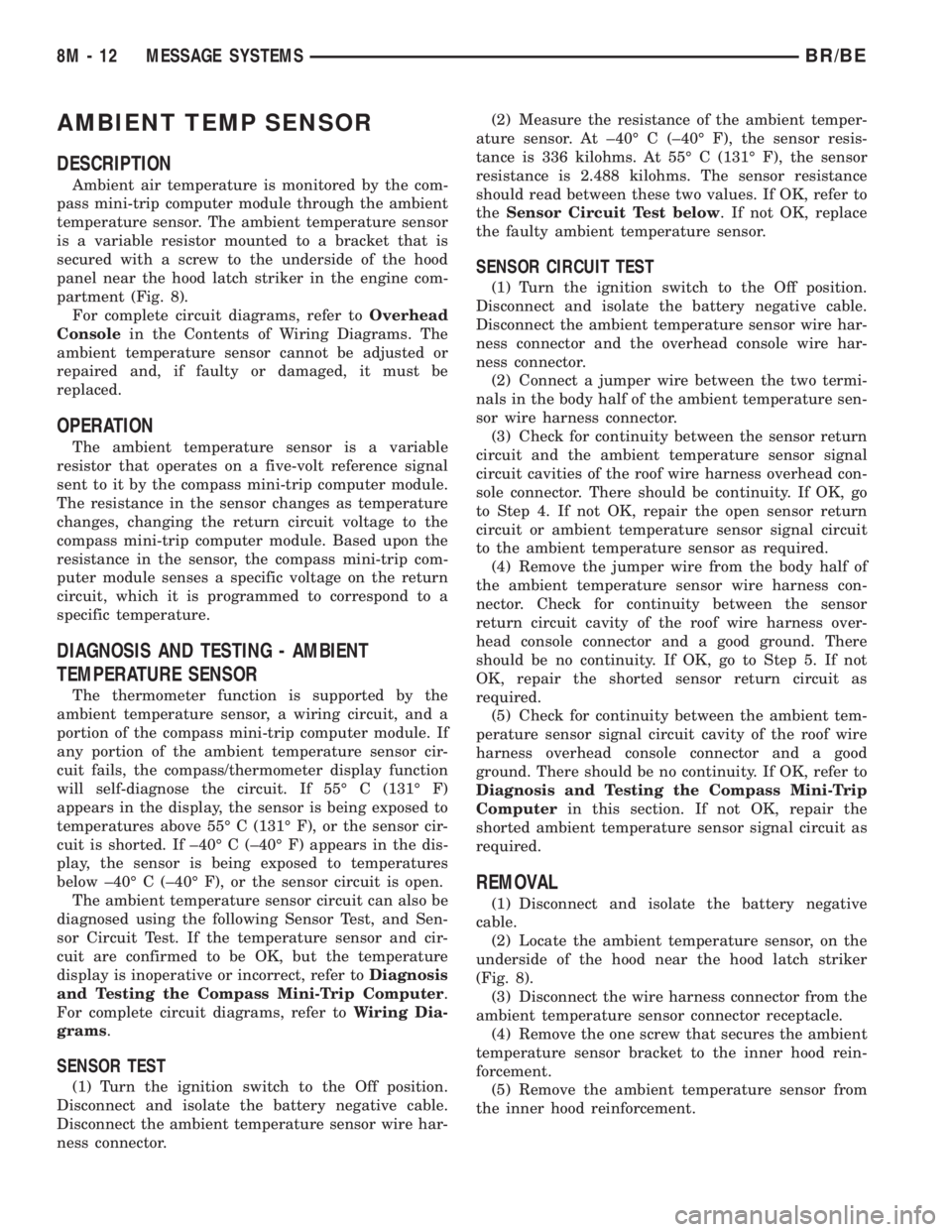
AMBIENT TEMP SENSOR
DESCRIPTION
Ambient air temperature is monitored by the com-
pass mini-trip computer module through the ambient
temperature sensor. The ambient temperature sensor
is a variable resistor mounted to a bracket that is
secured with a screw to the underside of the hood
panel near the hood latch striker in the engine com-
partment (Fig. 8).
For complete circuit diagrams, refer toOverhead
Consolein the Contents of Wiring Diagrams. The
ambient temperature sensor cannot be adjusted or
repaired and, if faulty or damaged, it must be
replaced.
OPERATION
The ambient temperature sensor is a variable
resistor that operates on a five-volt reference signal
sent to it by the compass mini-trip computer module.
The resistance in the sensor changes as temperature
changes, changing the return circuit voltage to the
compass mini-trip computer module. Based upon the
resistance in the sensor, the compass mini-trip com-
puter module senses a specific voltage on the return
circuit, which it is programmed to correspond to a
specific temperature.
DIAGNOSIS AND TESTING - AMBIENT
TEMPERATURE SENSOR
The thermometer function is supported by the
ambient temperature sensor, a wiring circuit, and a
portion of the compass mini-trip computer module. If
any portion of the ambient temperature sensor cir-
cuit fails, the compass/thermometer display function
will self-diagnose the circuit. If 55É C (131É F)
appears in the display, the sensor is being exposed to
temperatures above 55É C (131É F), or the sensor cir-
cuit is shorted. If ±40É C (±40É F) appears in the dis-
play, the sensor is being exposed to temperatures
below ±40É C (±40É F), or the sensor circuit is open.
The ambient temperature sensor circuit can also be
diagnosed using the following Sensor Test, and Sen-
sor Circuit Test. If the temperature sensor and cir-
cuit are confirmed to be OK, but the temperature
display is inoperative or incorrect, refer toDiagnosis
and Testing the Compass Mini-Trip Computer.
For complete circuit diagrams, refer toWiring Dia-
grams.
SENSOR TEST
(1) Turn the ignition switch to the Off position.
Disconnect and isolate the battery negative cable.
Disconnect the ambient temperature sensor wire har-
ness connector.(2) Measure the resistance of the ambient temper-
ature sensor. At ±40É C (±40É F), the sensor resis-
tance is 336 kilohms. At 55É C (131É F), the sensor
resistance is 2.488 kilohms. The sensor resistance
should read between these two values. If OK, refer to
theSensor Circuit Test below. If not OK, replace
the faulty ambient temperature sensor.
SENSOR CIRCUIT TEST
(1) Turn the ignition switch to the Off position.
Disconnect and isolate the battery negative cable.
Disconnect the ambient temperature sensor wire har-
ness connector and the overhead console wire har-
ness connector.
(2) Connect a jumper wire between the two termi-
nals in the body half of the ambient temperature sen-
sor wire harness connector.
(3) Check for continuity between the sensor return
circuit and the ambient temperature sensor signal
circuit cavities of the roof wire harness overhead con-
sole connector. There should be continuity. If OK, go
to Step 4. If not OK, repair the open sensor return
circuit or ambient temperature sensor signal circuit
to the ambient temperature sensor as required.
(4) Remove the jumper wire from the body half of
the ambient temperature sensor wire harness con-
nector. Check for continuity between the sensor
return circuit cavity of the roof wire harness over-
head console connector and a good ground. There
should be no continuity. If OK, go to Step 5. If not
OK, repair the shorted sensor return circuit as
required.
(5) Check for continuity between the ambient tem-
perature sensor signal circuit cavity of the roof wire
harness overhead console connector and a good
ground. There should be no continuity. If OK, refer to
Diagnosis and Testing the Compass Mini-Trip
Computerin this section. If not OK, repair the
shorted ambient temperature sensor signal circuit as
required.
REMOVAL
(1) Disconnect and isolate the battery negative
cable.
(2) Locate the ambient temperature sensor, on the
underside of the hood near the hood latch striker
(Fig. 8).
(3) Disconnect the wire harness connector from the
ambient temperature sensor connector receptacle.
(4) Remove the one screw that secures the ambient
temperature sensor bracket to the inner hood rein-
forcement.
(5) Remove the ambient temperature sensor from
the inner hood reinforcement.
8M - 12 MESSAGE SYSTEMSBR/BE
Page 1126 of 2255
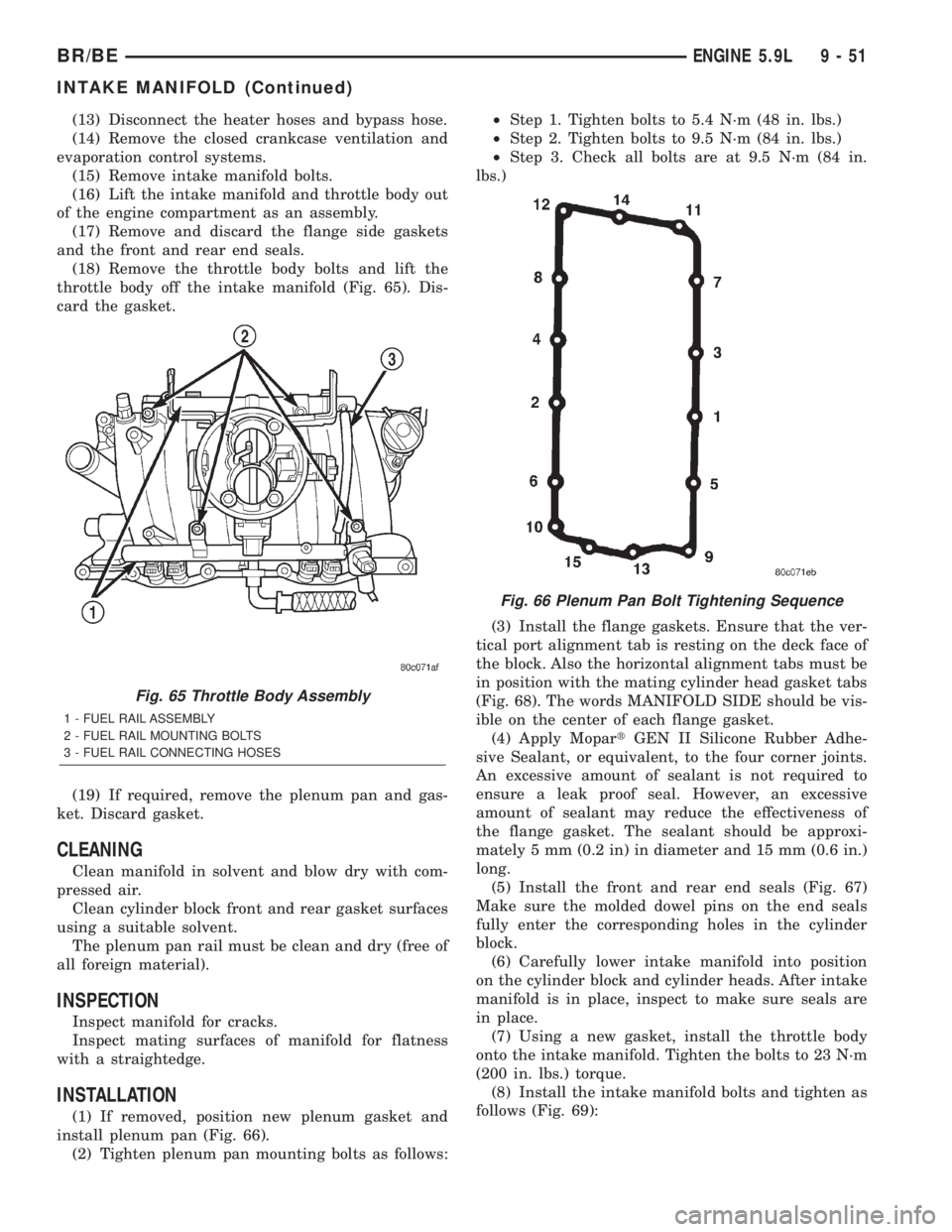
(13) Disconnect the heater hoses and bypass hose.
(14) Remove the closed crankcase ventilation and
evaporation control systems.
(15) Remove intake manifold bolts.
(16) Lift the intake manifold and throttle body out
of the engine compartment as an assembly.
(17) Remove and discard the flange side gaskets
and the front and rear end seals.
(18) Remove the throttle body bolts and lift the
throttle body off the intake manifold (Fig. 65). Dis-
card the gasket.
(19) If required, remove the plenum pan and gas-
ket. Discard gasket.
CLEANING
Clean manifold in solvent and blow dry with com-
pressed air.
Clean cylinder block front and rear gasket surfaces
using a suitable solvent.
The plenum pan rail must be clean and dry (free of
all foreign material).
INSPECTION
Inspect manifold for cracks.
Inspect mating surfaces of manifold for flatness
with a straightedge.
INSTALLATION
(1) If removed, position new plenum gasket and
install plenum pan (Fig. 66).
(2) Tighten plenum pan mounting bolts as follows:²Step 1. Tighten bolts to 5.4 N´m (48 in. lbs.)
²Step 2. Tighten bolts to 9.5 N´m (84 in. lbs.)
²Step 3. Check all bolts are at 9.5 N´m (84 in.
lbs.)
(3) Install the flange gaskets. Ensure that the ver-
tical port alignment tab is resting on the deck face of
the block. Also the horizontal alignment tabs must be
in position with the mating cylinder head gasket tabs
(Fig. 68). The words MANIFOLD SIDE should be vis-
ible on the center of each flange gasket.
(4) Apply MopartGEN II Silicone Rubber Adhe-
sive Sealant, or equivalent, to the four corner joints.
An excessive amount of sealant is not required to
ensure a leak proof seal. However, an excessive
amount of sealant may reduce the effectiveness of
the flange gasket. The sealant should be approxi-
mately 5 mm (0.2 in) in diameter and 15 mm (0.6 in.)
long.
(5) Install the front and rear end seals (Fig. 67)
Make sure the molded dowel pins on the end seals
fully enter the corresponding holes in the cylinder
block.
(6) Carefully lower intake manifold into position
on the cylinder block and cylinder heads. After intake
manifold is in place, inspect to make sure seals are
in place.
(7) Using a new gasket, install the throttle body
onto the intake manifold. Tighten the bolts to 23 N´m
(200 in. lbs.) torque.
(8) Install the intake manifold bolts and tighten as
follows (Fig. 69):
Fig. 65 Throttle Body Assembly
1 - FUEL RAIL ASSEMBLY
2 - FUEL RAIL MOUNTING BOLTS
3 - FUEL RAIL CONNECTING HOSES
Fig. 66 Plenum Pan Bolt Tightening Sequence
BR/BEENGINE 5.9L 9 - 51
INTAKE MANIFOLD (Continued)
Page 1183 of 2255
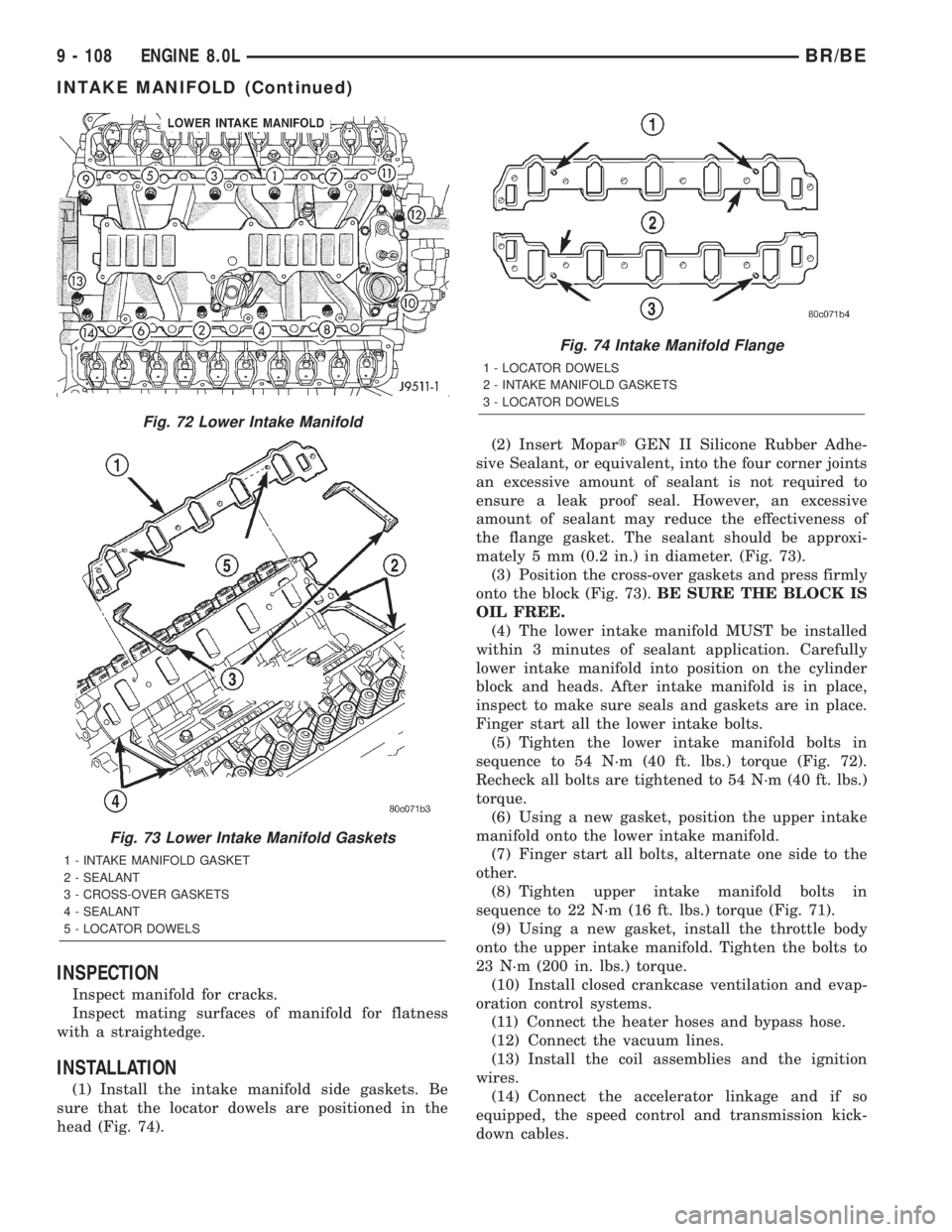
INSPECTION
Inspect manifold for cracks.
Inspect mating surfaces of manifold for flatness
with a straightedge.
INSTALLATION
(1) Install the intake manifold side gaskets. Be
sure that the locator dowels are positioned in the
head (Fig. 74).(2) Insert MopartGEN II Silicone Rubber Adhe-
sive Sealant, or equivalent, into the four corner joints
an excessive amount of sealant is not required to
ensure a leak proof seal. However, an excessive
amount of sealant may reduce the effectiveness of
the flange gasket. The sealant should be approxi-
mately 5 mm (0.2 in.) in diameter. (Fig. 73).
(3) Position the cross-over gaskets and press firmly
onto the block (Fig. 73).BE SURE THE BLOCK IS
OIL FREE.
(4) The lower intake manifold MUST be installed
within 3 minutes of sealant application. Carefully
lower intake manifold into position on the cylinder
block and heads. After intake manifold is in place,
inspect to make sure seals and gaskets are in place.
Finger start all the lower intake bolts.
(5) Tighten the lower intake manifold bolts in
sequence to 54 N´m (40 ft. lbs.) torque (Fig. 72).
Recheck all bolts are tightened to 54 N´m (40 ft. lbs.)
torque.
(6) Using a new gasket, position the upper intake
manifold onto the lower intake manifold.
(7) Finger start all bolts, alternate one side to the
other.
(8) Tighten upper intake manifold bolts in
sequence to 22 N´m (16 ft. lbs.) torque (Fig. 71).
(9) Using a new gasket, install the throttle body
onto the upper intake manifold. Tighten the bolts to
23 N´m (200 in. lbs.) torque.
(10) Install closed crankcase ventilation and evap-
oration control systems.
(11) Connect the heater hoses and bypass hose.
(12) Connect the vacuum lines.
(13) Install the coil assemblies and the ignition
wires.
(14) Connect the accelerator linkage and if so
equipped, the speed control and transmission kick-
down cables.
Fig. 72 Lower Intake Manifold
Fig. 73 Lower Intake Manifold Gaskets
1 - INTAKE MANIFOLD GASKET
2 - SEALANT
3 - CROSS-OVER GASKETS
4 - SEALANT
5 - LOCATOR DOWELS
Fig. 74 Intake Manifold Flange
1 - LOCATOR DOWELS
2 - INTAKE MANIFOLD GASKETS
3 - LOCATOR DOWELS
9 - 108 ENGINE 8.0LBR/BE
INTAKE MANIFOLD (Continued)
Page 2094 of 2255
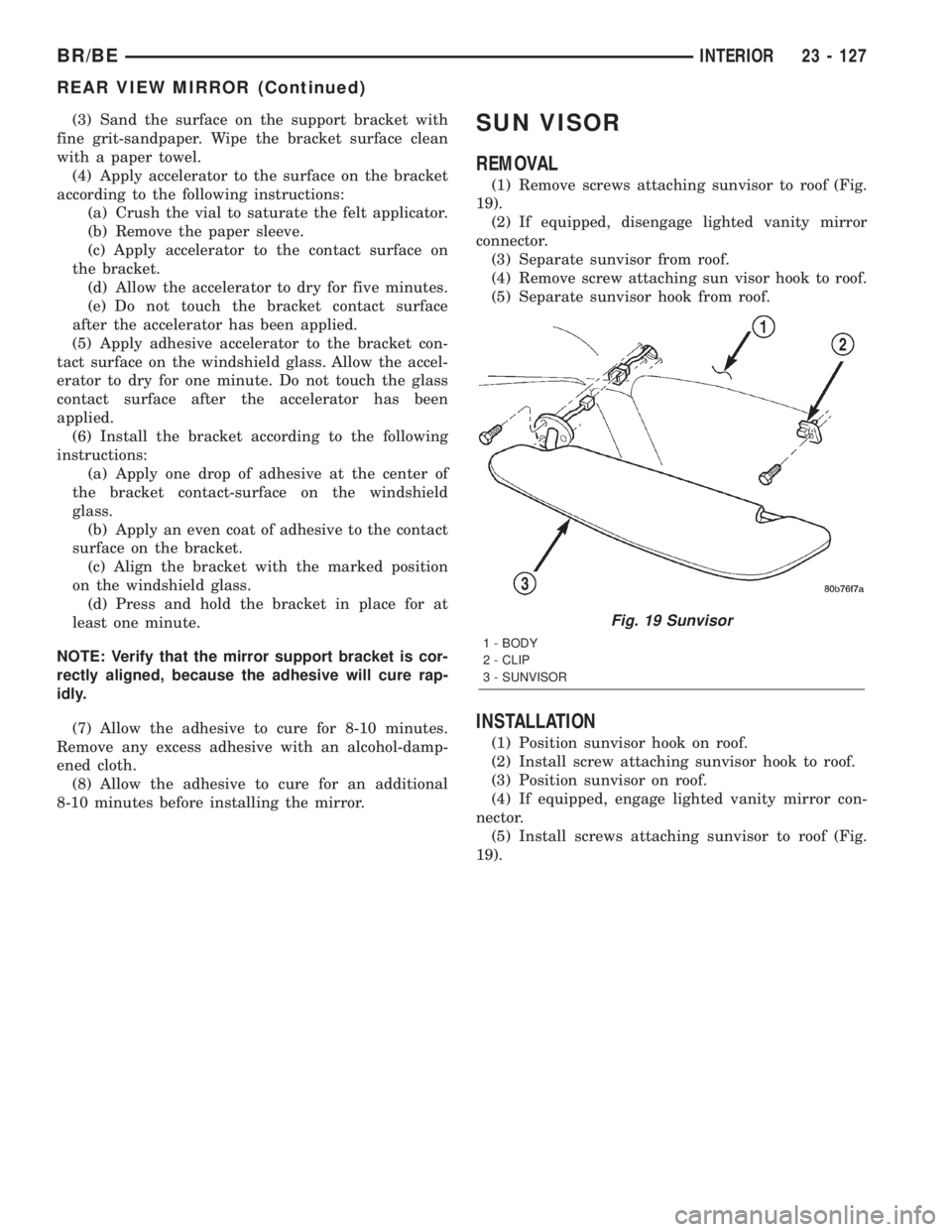
(3) Sand the surface on the support bracket with
fine grit-sandpaper. Wipe the bracket surface clean
with a paper towel.
(4) Apply accelerator to the surface on the bracket
according to the following instructions:
(a) Crush the vial to saturate the felt applicator.
(b) Remove the paper sleeve.
(c) Apply accelerator to the contact surface on
the bracket.
(d) Allow the accelerator to dry for five minutes.
(e) Do not touch the bracket contact surface
after the accelerator has been applied.
(5) Apply adhesive accelerator to the bracket con-
tact surface on the windshield glass. Allow the accel-
erator to dry for one minute. Do not touch the glass
contact surface after the accelerator has been
applied.
(6) Install the bracket according to the following
instructions:
(a) Apply one drop of adhesive at the center of
the bracket contact-surface on the windshield
glass.
(b) Apply an even coat of adhesive to the contact
surface on the bracket.
(c) Align the bracket with the marked position
on the windshield glass.
(d) Press and hold the bracket in place for at
least one minute.
NOTE: Verify that the mirror support bracket is cor-
rectly aligned, because the adhesive will cure rap-
idly.
(7) Allow the adhesive to cure for 8-10 minutes.
Remove any excess adhesive with an alcohol-damp-
ened cloth.
(8) Allow the adhesive to cure for an additional
8-10 minutes before installing the mirror.SUN VISOR
REMOVAL
(1) Remove screws attaching sunvisor to roof (Fig.
19).
(2) If equipped, disengage lighted vanity mirror
connector.
(3) Separate sunvisor from roof.
(4) Remove screw attaching sun visor hook to roof.
(5) Separate sunvisor hook from roof.
INSTALLATION
(1) Position sunvisor hook on roof.
(2) Install screw attaching sunvisor hook to roof.
(3) Position sunvisor on roof.
(4) If equipped, engage lighted vanity mirror con-
nector.
(5) Install screws attaching sunvisor to roof (Fig.
19).
Fig. 19 Sunvisor
1 - BODY
2 - CLIP
3 - SUNVISOR
BR/BEINTERIOR 23 - 127
REAR VIEW MIRROR (Continued)
Page 2115 of 2255
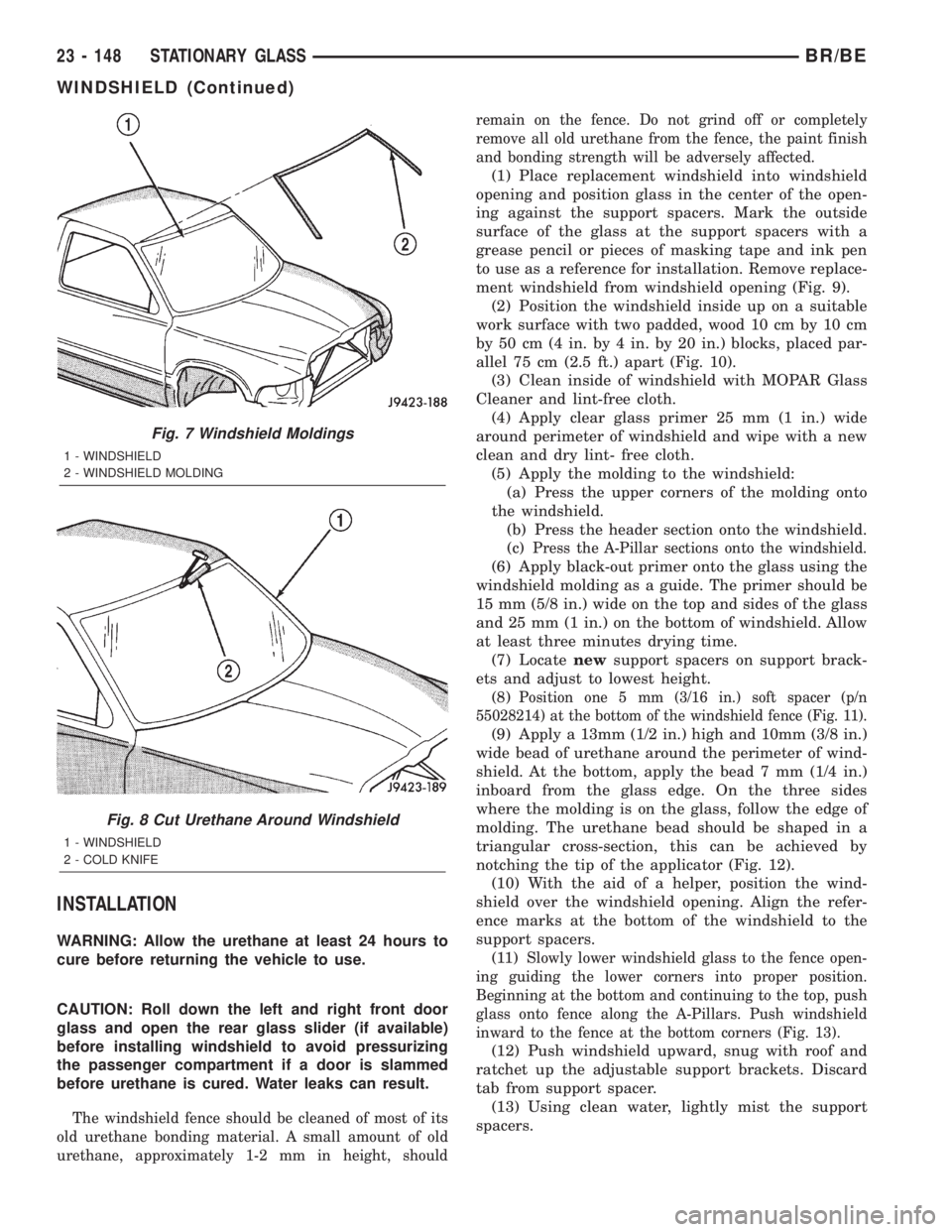
INSTALLATION
WARNING: Allow the urethane at least 24 hours to
cure before returning the vehicle to use.
CAUTION: Roll down the left and right front door
glass and open the rear glass slider (if available)
before installing windshield to avoid pressurizing
the passenger compartment if a door is slammed
before urethane is cured. Water leaks can result.
The windshield fence should be cleaned of most of its
old urethane bonding material. A small amount of old
urethane, approximately 1-2 mm in height, shouldremain on the fence. Do not grind off or completely
remove all old urethane from the fence, the paint finish
and bonding strength will be adversely affected.
(1) Place replacement windshield into windshield
opening and position glass in the center of the open-
ing against the support spacers. Mark the outside
surface of the glass at the support spacers with a
grease pencil or pieces of masking tape and ink pen
to use as a reference for installation. Remove replace-
ment windshield from windshield opening (Fig. 9).
(2) Position the windshield inside up on a suitable
work surface with two padded, wood 10 cm by 10 cm
by 50 cm (4 in. by 4 in. by 20 in.) blocks, placed par-
allel 75 cm (2.5 ft.) apart (Fig. 10).
(3) Clean inside of windshield with MOPAR Glass
Cleaner and lint-free cloth.
(4) Apply clear glass primer 25 mm (1 in.) wide
around perimeter of windshield and wipe with a new
clean and dry lint- free cloth.
(5) Apply the molding to the windshield:
(a) Press the upper corners of the molding onto
the windshield.
(b) Press the header section onto the windshield.
(c)
Press the A-Pillar sections onto the windshield.
(6) Apply black-out primer onto the glass using the
windshield molding as a guide. The primer should be
15 mm (5/8 in.) wide on the top and sides of the glass
and 25 mm (1 in.) on the bottom of windshield. Allow
at least three minutes drying time.
(7) Locatenewsupport spacers on support brack-
ets and adjust to lowest height.
(8)
Position one 5 mm (3/16 in.) soft spacer (p/n
55028214) at the bottom of the windshield fence (Fig. 11).
(9) Apply a 13mm (1/2 in.) high and 10mm (3/8 in.)
wide bead of urethane around the perimeter of wind-
shield. At the bottom, apply the bead 7 mm (1/4 in.)
inboard from the glass edge. On the three sides
where the molding is on the glass, follow the edge of
molding. The urethane bead should be shaped in a
triangular cross-section, this can be achieved by
notching the tip of the applicator (Fig. 12).
(10) With the aid of a helper, position the wind-
shield over the windshield opening. Align the refer-
ence marks at the bottom of the windshield to the
support spacers.
(11)
Slowly lower windshield glass to the fence open-
ing guiding the lower corners into proper position.
Beginning at the bottom and continuing to the top, push
glass onto fence along the A-Pillars. Push windshield
inward to the fence at the bottom corners (Fig. 13).
(12) Push windshield upward, snug with roof and
ratchet up the adjustable support brackets. Discard
tab from support spacer.
(13) Using clean water, lightly mist the support
spacers.
Fig. 7 Windshield Moldings
1 - WINDSHIELD
2 - WINDSHIELD MOLDING
Fig. 8 Cut Urethane Around Windshield
1 - WINDSHIELD
2 - COLD KNIFE
23 - 148 STATIONARY GLASSBR/BE
WINDSHIELD (Continued)
Page 2237 of 2255
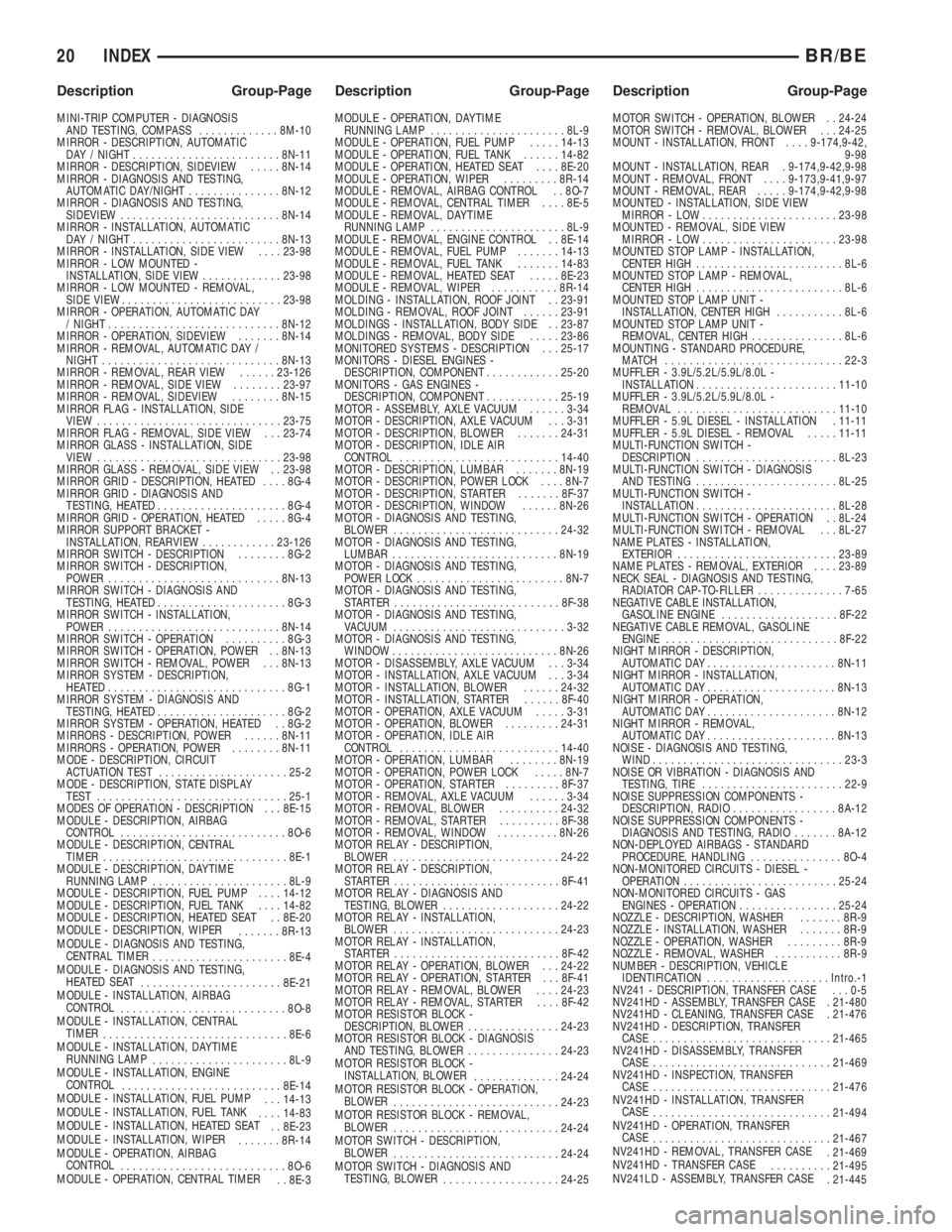
MINI-TRIP COMPUTER - DIAGNOSIS
AND TESTING, COMPASS.............8M-10
MIRROR - DESCRIPTION, AUTOMATIC
DAY / NIGHT........................8N-11
MIRROR - DESCRIPTION, SIDEVIEW.....8N-14
MIRROR - DIAGNOSIS AND TESTING,
AUTOMATIC DAY/NIGHT...............8N-12
MIRROR - DIAGNOSIS AND TESTING,
SIDEVIEW..........................8N-14
MIRROR - INSTALLATION, AUTOMATIC
DAY / NIGHT........................8N-13
MIRROR - INSTALLATION, SIDE VIEW....23-98
MIRROR - LOW MOUNTED -
INSTALLATION, SIDE VIEW.............23-98
MIRROR - LOW MOUNTED - REMOVAL,
SIDE VIEW..........................23-98
MIRROR - OPERATION, AUTOMATIC DAY
/ NIGHT............................8N-12
MIRROR - OPERATION, SIDEVIEW.......8N-14
MIRROR - REMOVAL, AUTOMATIC DAY /
NIGHT.............................8N-13
MIRROR - REMOVAL, REAR VIEW......23-126
MIRROR - REMOVAL, SIDE VIEW........23-97
MIRROR - REMOVAL, SIDEVIEW........8N-15
MIRROR FLAG - INSTALLATION, SIDE
VIEW..............................23-75
MIRROR FLAG - REMOVAL, SIDE VIEW . . . 23-74
MIRROR GLASS - INSTALLATION, SIDE
VIEW..............................23-98
MIRROR GLASS - REMOVAL, SIDE VIEW . . 23-98
MIRROR GRID - DESCRIPTION, HEATED....8G-4
MIRROR GRID - DIAGNOSIS AND
TESTING, HEATED.....................8G-4
MIRROR GRID - OPERATION, HEATED.....8G-4
MIRROR SUPPORT BRACKET -
INSTALLATION, REARVIEW............23-126
MIRROR SWITCH - DESCRIPTION........8G-2
MIRROR SWITCH - DESCRIPTION,
POWER............................8N-13
MIRROR SWITCH - DIAGNOSIS AND
TESTING, HEATED.....................8G-3
MIRROR SWITCH - INSTALLATION,
POWER............................8N-14
MIRROR SWITCH - OPERATION..........8G-3
MIRROR SWITCH - OPERATION, POWER . . 8N-13
MIRROR SWITCH - REMOVAL, POWER . . . 8N-13
MIRROR SYSTEM - DESCRIPTION,
HEATED.............................8G-1
MIRROR SYSTEM - DIAGNOSIS AND
TESTING, HEATED.....................8G-2
MIRROR SYSTEM - OPERATION, HEATED . . 8G-2
MIRRORS - DESCRIPTION, POWER......8N-11
MIRRORS - OPERATION, POWER........8N-11
MODE - DESCRIPTION, CIRCUIT
ACTUATION TEST.....................25-2
MODE - DESCRIPTION, STATE DISPLAY
TEST...............................25-1
MODES OF OPERATION - DESCRIPTION . . . 8E-15
MODULE - DESCRIPTION, AIRBAG
CONTROL...........................8O-6
MODULE - DESCRIPTION, CENTRAL
TIMER..............................8E-1
MODULE - DESCRIPTION, DAYTIME
RUNNING LAMP......................8L-9
MODULE - DESCRIPTION, FUEL PUMP....14-12
MODULE - DESCRIPTION, FUEL TANK....14-82
MODULE - DESCRIPTION, HEATED SEAT . . 8E-20
MODULE - DESCRIPTION, WIPER
.......8R-13
MODULE - DIAGNOSIS AND TESTING,
CENTRAL TIMER
......................8E-4
MODULE - DIAGNOSIS AND TESTING,
HEATED SEAT
.......................8E-21
MODULE - INSTALLATION, AIRBAG
CONTROL
...........................8O-8
MODULE - INSTALLATION, CENTRAL
TIMER
..............................8E-6
MODULE - INSTALLATION, DAYTIME
RUNNING LAMP
......................8L-9
MODULE - INSTALLATION, ENGINE
CONTROL
..........................8E-14
MODULE - INSTALLATION, FUEL PUMP
. . . 14-13
MODULE - INSTALLATION, FUEL TANK
....14-83
MODULE - INSTALLATION, HEATED SEAT
. . 8E-23
MODULE - INSTALLATION, WIPER
.......8R-14
MODULE - OPERATION, AIRBAG
CONTROL
...........................8O-6
MODULE - OPERATION, CENTRAL TIMER
. . 8E-3MODULE - OPERATION, DAYTIME
RUNNING LAMP......................8L-9
MODULE - OPERATION, FUEL PUMP.....14-13
MODULE - OPERATION, FUEL TANK......14-82
MODULE - OPERATION, HEATED SEAT....8E-20
MODULE - OPERATION, WIPER.........8R-14
MODULE - REMOVAL, AIRBAG CONTROL . . 8O-7
MODULE - REMOVAL, CENTRAL TIMER....8E-5
MODULE - REMOVAL, DAYTIME
RUNNING LAMP......................8L-9
MODULE - REMOVAL, ENGINE CONTROL . . 8E-14
MODULE - REMOVAL, FUEL PUMP.......14-13
MODULE - REMOVAL, FUEL TANK.......14-83
MODULE - REMOVAL, HEATED SEAT.....8E-23
MODULE - REMOVAL, WIPER...........8R-14
MOLDING - INSTALLATION, ROOF JOINT . . 23-91
MOLDING - REMOVAL, ROOF JOINT......23-91
MOLDINGS - INSTALLATION, BODY SIDE . . 23-87
MOLDINGS - REMOVAL, BODY SIDE.....23-86
MONITORED SYSTEMS - DESCRIPTION . . . 25-17
MONITORS - DIESEL ENGINES -
DESCRIPTION, COMPONENT............25-20
MONITORS - GAS ENGINES -
DESCRIPTION, COMPONENT............25-19
MOTOR - ASSEMBLY, AXLE VACUUM......3-34
MOTOR - DESCRIPTION, AXLE VACUUM . . . 3-31
MOTOR - DESCRIPTION, BLOWER.......24-31
MOTOR - DESCRIPTION, IDLE AIR
CONTROL..........................14-40
MOTOR - DESCRIPTION, LUMBAR.......8N-19
MOTOR - DESCRIPTION, POWER LOCK....8N-7
MOTOR - DESCRIPTION, STARTER.......8F-37
MOTOR - DESCRIPTION, WINDOW......8N-26
MOTOR - DIAGNOSIS AND TESTING,
BLOWER...........................24-32
MOTOR - DIAGNOSIS AND TESTING,
LUMBAR...........................8N-19
MOTOR - DIAGNOSIS AND TESTING,
POWER LOCK........................8N-7
MOTOR - DIAGNOSIS AND TESTING,
STARTER ...........................8F-38
MOTOR - DIAGNOSIS AND TESTING,
VACUUM............................3-32
MOTOR - DIAGNOSIS AND TESTING,
WINDOW...........................8N-26
MOTOR - DISASSEMBLY, AXLE VACUUM . . . 3-34
MOTOR - INSTALLATION, AXLE VACUUM . . . 3-34
MOTOR - INSTALLATION, BLOWER......24-32
MOTOR - INSTALLATION, STARTER......8F-40
MOTOR - OPERATION, AXLE VACUUM.....3-31
MOTOR - OPERATION, BLOWER.........24-31
MOTOR - OPERATION, IDLE AIR
CONTROL..........................14-40
MOTOR - OPERATION, LUMBAR........8N-19
MOTOR - OPERATION, POWER LOCK.....8N-7
MOTOR - OPERATION, STARTER.........8F-37
MOTOR - REMOVAL, AXLE VACUUM......3-34
MOTOR - REMOVAL, BLOWER..........24-32
MOTOR - REMOVAL, STARTER..........8F-38
MOTOR - REMOVAL, WINDOW..........8N-26
MOTOR RELAY - DESCRIPTION,
BLOWER...........................24-22
MOTOR RELAY - DESCRIPTION,
STARTER ...........................8F-41
MOTOR RELAY - DIAGNOSIS AND
TESTING, BLOWER...................24-22
MOTOR RELAY - INSTALLATION,
BLOWER...........................24-23
MOTOR RELAY - INSTALLATION,
STARTER ...........................8F-42
MOTOR RELAY - OPERATION, BLOWER . . . 24-22
MOTOR RELAY - OPERATION, STARTER . . . 8F-41
MOTOR RELAY - REMOVAL, BLOWER....24-23
MOTOR RELAY - REMOVAL, STARTER....8F-42
MOTOR RESISTOR BLOCK -
DESCRIPTION, BLOWER...............24-23
MOTOR RESISTOR BLOCK - DIAGNOSIS
AND TESTING, BLOWER...............24-23
MOTOR RESISTOR BLOCK -
INSTALLATION, BLOWER
..............24-24
MOTOR RESISTOR BLOCK - OPERATION,
BLOWER
...........................24-23
MOTOR RESISTOR BLOCK - REMOVAL,
BLOWER
...........................24-24
MOTOR SWITCH - DESCRIPTION,
BLOWER
...........................24-24
MOTOR SWITCH - DIAGNOSIS AND
TESTING, BLOWER
...................24-25MOTOR SWITCH - OPERATION, BLOWER . . 24-24
MOTOR SWITCH - REMOVAL, BLOWER . . . 24-25
MOUNT - INSTALLATION, FRONT....9-174,9-42,
9-98
MOUNT - INSTALLATION, REAR . 9-174,9-42,9-98
MOUNT - REMOVAL, FRONT....9-173,9-41,9-97
MOUNT - REMOVAL, REAR.....9-174,9-42,9-98
MOUNTED - INSTALLATION, SIDE VIEW
MIRROR - LOW......................23-98
MOUNTED - REMOVAL, SIDE VIEW
MIRROR - LOW......................23-98
MOUNTED STOP LAMP - INSTALLATION,
CENTER HIGH........................8L-6
MOUNTED STOP LAMP - REMOVAL,
CENTER HIGH........................8L-6
MOUNTED STOP LAMP UNIT -
INSTALLATION, CENTER HIGH...........8L-6
MOUNTED STOP LAMP UNIT -
REMOVAL, CENTER HIGH...............8L-6
MOUNTING - STANDARD PROCEDURE,
MATCH .............................22-3
MUFFLER - 3.9L/5.2L/5.9L/8.0L -
INSTALLATION.......................11-10
MUFFLER - 3.9L/5.2L/5.9L/8.0L -
REMOVAL..........................11-10
MUFFLER - 5.9L DIESEL - INSTALLATION . 11-11
MUFFLER - 5.9L DIESEL - REMOVAL.....11-11
MULTI-FUNCTION SWITCH -
DESCRIPTION.......................8L-23
MULTI-FUNCTION SWITCH - DIAGNOSIS
AND TESTING.......................8L-25
MULTI-FUNCTION SWITCH -
INSTALLATION.......................8L-28
MULTI-FUNCTION SWITCH - OPERATION . . 8L-24
MULTI-FUNCTION SWITCH - REMOVAL . . . 8L-27
NAME PLATES - INSTALLATION,
EXTERIOR..........................23-89
NAME PLATES - REMOVAL, EXTERIOR....23-89
NECK SEAL - DIAGNOSIS AND TESTING,
RADIATOR CAP-TO-FILLER..............7-65
NEGATIVE CABLE INSTALLATION,
GASOLINE ENGINE...................8F-22
NEGATIVE CABLE REMOVAL, GASOLINE
ENGINE............................8F-22
NIGHT MIRROR - DESCRIPTION,
AUTOMATIC DAY.....................8N-11
NIGHT MIRROR - INSTALLATION,
AUTOMATIC DAY.....................8N-13
NIGHT MIRROR - OPERATION,
AUTOMATIC DAY.....................8N-12
NIGHT MIRROR - REMOVAL,
AUTOMATIC DAY.....................8N-13
NOISE - DIAGNOSIS AND TESTING,
WIND...............................23-3
NOISE OR VIBRATION - DIAGNOSIS AND
TESTING, TIRE.......................22-9
NOISE SUPPRESSION COMPONENTS -
DESCRIPTION, RADIO.................8A-12
NOISE SUPPRESSION COMPONENTS -
DIAGNOSIS AND TESTING, RADIO.......8A-12
NON-DEPLOYED AIRBAGS - STANDARD
PROCEDURE, HANDLING...............8O-4
NON-MONITORED CIRCUITS - DIESEL -
OPERATION.........................25-24
NON-MONITORED CIRCUITS - GAS
ENGINES - OPERATION................25-24
NOZZLE - DESCRIPTION, WASHER.......8R-9
NOZZLE - INSTALLATION, WASHER.......8R-9
NOZZLE - OPERATION, WASHER.........8R-9
NOZZLE - REMOVAL, WASHER...........8R-9
NUMBER - DESCRIPTION, VEHICLE
IDENTIFICATION....................Intro.-1
NV241 - DESCRIPTION, TRANSFER CASE . . . 0-5
NV241HD - ASSEMBLY, TRANSFER CASE . 21-480
NV241HD - CLEANING, TRANSFER CASE . 21-476
NV241HD - DESCRIPTION, TRANSFER
CASE.............................21-465
NV241HD - DISASSEMBLY, TRANSFER
CASE.............................21-469
NV241HD - INSPECTION, TRANSFER
CASE.............................21-476
NV241HD - INSTALLATION, TRANSFER
CASE
.............................21-494
NV241HD - OPERATION, TRANSFER
CASE
.............................21-467
NV241HD - REMOVAL, TRANSFER CASE
. 21-469
NV241HD - TRANSFER CASE
..........21-495
NV241LD - ASSEMBLY, TRANSFER CASE
. 21-445
20 INDEXBR/BE
Description Group-Page Description Group-Page Description Group-Page